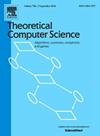Complete decomposition of symmetric tensors in linear time and polylogarithmic precision
IF 0.9
4区 计算机科学
Q3 COMPUTER SCIENCE, THEORY & METHODS
引用次数: 0
Abstract
We study symmetric tensor decompositions, i.e., decompositions of the form where T is a symmetric tensor of order 3 and . In order to obtain efficient decomposition algorithms, it is necessary to require additional properties from the . In this paper we assume that the are linearly independent. This implies , i.e., the decomposition of T is undercomplete. We will moreover assume that (we plan to extend this work to the case in a forthcoming paper).
We give a randomized algorithm for the following problem: given T, an accuracy parameter ε, and an upper bound B on the condition number of the tensor, output vectors such that (up to permutation and multiplication by phases) with high probability. The main novel features of our algorithm are:
- •We provide the first algorithm for this problem that works in the computation model of finite arithmetic and requires only poly-logarithmic (in and ) many bits of precision.
- •Moreover, this is also the first algorithm that runs in linear time in the size of the input tensor. It requires arithmetic operations for all accuracy parameters .
In order to obtain these results, we rely on a mix of techniques from algorithm design and algorithm analysis. The algorithm is a modified version of simultaneous diagonalisation algorithm for symmetric tensors. In terms of algorithm design, our main contribution lies in replacing the usual appeal to resolution of a linear system of equations [30], [7] by a matrix trace-based method. The analysis of the algorithm depends on the following components:
- 1.We use the fast and numerically stable diagonalisation algorithm from [9]. We provide better guarantees for the approximate solution returned by the diagonalisation algorithm when the input matrix is diagonalisable.
- 2.We show strong anti-concentration bounds for certain families of polynomials when the randomness is sampled uniformly from a discrete grid.
求助全文
约1分钟内获得全文
求助全文
来源期刊

Theoretical Computer Science
工程技术-计算机:理论方法
CiteScore
2.60
自引率
18.20%
发文量
471
审稿时长
12.6 months
期刊介绍:
Theoretical Computer Science is mathematical and abstract in spirit, but it derives its motivation from practical and everyday computation. Its aim is to understand the nature of computation and, as a consequence of this understanding, provide more efficient methodologies. All papers introducing or studying mathematical, logic and formal concepts and methods are welcome, provided that their motivation is clearly drawn from the field of computing.
 求助内容:
求助内容: 应助结果提醒方式:
应助结果提醒方式:


